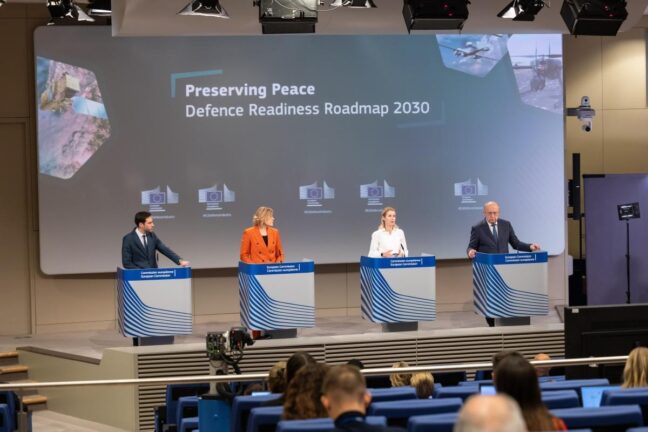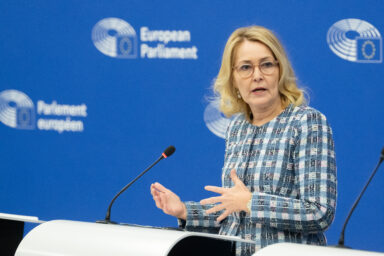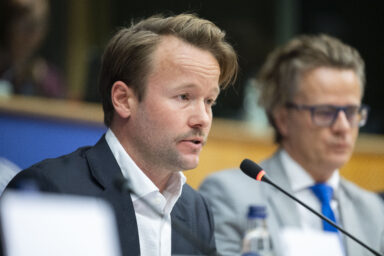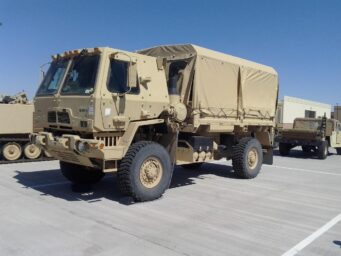EU member states are to form coalitions across nine capability areas, ramp joint procurement to 40 per cent by 2027 and deliver an anti‑drone system by end‑2027, an EU military‑mobility area by 2027 and an Eastern Flank Watch by 2028. Brussels seeeks to speed up contracts and scale output.
The European Commission unveiled the Preserving Peace‑Defence Readiness Roadmap 2030 on 16 October 2025. Commission President Ursula von der Leyen said plainly: “The recent threats have shown that Europe is at risk. We have to protect every citizen and square centimetre of our territory.” The Roadmap asks member states to form capability coalitions in nine domains and to launch four initial European flagships.
The document links finance, industry and procurement. It aims to move from opportunity to delivery. “This will strengthen our defence industries, accelerate production and maintain our long‑standing support to Ukraine,” Ms von der Leyen added. The Commission will monitor progress annually.
Flagships to start work
The plan sets concrete targets. It names air and missile defence; strategic enablers; military mobility; artillery systems; cyber, AI and electronic warfare; missiles and ammunition; drones and counter‑drones; ground combat; and maritime as priority coalitions. The Roadmap ties these coalitions to the Re‑Arm Europe Plan/Readiness 2030 and to instruments such as SAFE loans and the activation of the national escape clause of the Stability and Growth Pact.
Henna Virkkunen, Commission Vice‑President, said the College had adopted “a vital roadmap that will guide us to European defence readiness by 2030 with very concrete goals and milestones.” Ms Virkkunen urged haste. “To be ready by 2030, we need to move now, and we need to move fast, and we need to move together.” She announced four flagships: the European Drone Defence Initiative, the Eastern Flank Watch, the European Air Shield and the Defence Space Shield.
You might be interested
Ms Virkkunen stressed that the projects would serve NATO aims too. “These flagships, they will reinforce Europe’s ability to deter and defend across land, air, sea, cyber and space, while contributing directly to NATO capability targets.” She noted the list could expand if threats or technology shifted. The Roadmap will be subject to an annual reporting cycle to the European Council.
The Commission will focus early monitoring on air and missile defence, drones and space systems. Ms Virkkunen also set targets for budgetary leverage in the next multiannual financial framework—“we are proposing five times more funding than we have today” for defence and space and a major boost to military mobility funding.
Money and scale
Andrius Kubilius, Commissioner, framed the roadmap as a delivery plan. “It is, I quote, it is imperative that when it comes to our own defense posture, we are coordinated, we are precise, and we are fast. End of quote.” Mr Kubilius described the exercise as a “mega plan for delivery with clear timetables, goals, and reporting obligation.”
He supplied stark figures. “Roadmap indicates Europeans are going to invest till 2035 6.8 trillion euros. Into real defense, that’s usually around 50%, which means 3.4 trillion euros.” Mr Kubilius said much of that would be national spending and that EU instruments would mainly steer and incentivise cooperation. He warned that Europe is currently at only around half of NATO capability targets and must move to delivery—contracts, production and procurement.
We are proposing five times more funding than we have today. — Henna Virkkunen, European Commission vice-president
Joint procurement is central. Mr Kubilius set an ambition to raise joint procurement from roughly 20% today to 40% by the end of 2027. He argued this could cut costs and generate industrial scale: “incentivization for joint procurement can cut prices for defense production by 30%.” He also estimated long‑run savings of up to €200bn for national governments via pooled buying.
Ukraine is not the end
Kaja Kallas, High Representative, cast the Roadmap as prevention. “This roadmap for defense readiness is a plan to keep peace,” she said. Ms Kallas warned that risk would not vanish if the war in Ukraine ended: “Danger will not disappear even if the war in Ukraine will end.” She insisted member states remain “in the driving seat.”
Ms Kallas described how coalitions will work. She said: “Only by working together, we can address the most demanding capability shortfalls. And this is why we propose that member states work together in coalitions where the member states cannot work alone because anybody is not big enough.” She gave assurance that the European Defence Agency would aggregate demand, advise and link states to industry.
Ukraine featured repeatedly. Ms Kallas said: “Ukraine is still Europe’s first line of defense. That is why security guarantees for Ukraine are also part of the roadmap.” She proposed establishing a drone alliance with Ukraine by early next year and praised Ukrainian innovation seen during recent visits: “we have to use their experience from the battleground, but also their innovation to build on it together.”
Eastern flank and drones
The Eastern Flank Watch attracted sustained attention. Ms Kallas set a readiness goal: the package should be ready by 2028. “Eastern flank watch will bring all the capabilities needed to defend this part of Europe together,” she said, listing counter‑drone systems, ground defence, air defences, maritime assets and border management.
Today we propose a new anti‑drone system to be fully operational by the end of 2027. —- Kaja Kallas, EU defence and foreign affairs chief
Mr Kubilius sketched what the projects might contain on the ground—detection networks, anti‑drone interceptors, electronic‑warfare tools and even reconfigured terrain to hinder armoured advance. He cited early work by Poland and the Baltic states and offered a practical cost example: “for those four countries, they evaluated that it will cost around a billion euros,” referring to an initial drone‑defence concept.
The Commission has already opened a first drones coalition meeting, led by the Netherlands and Latvia. Ms Kallas declared an operational target: “Today we propose a new anti‑drone system to be fully operational by the end of 2027.” The approach is layered—sensors, interceptors, electronic measures and kinetic systems—learned from Ukrainian experience.
Industrial policy and market
The Roadmap demands a more integrated defence equipment market. Mr Kubilius called for new instruments such as European Defence Projects of Common Interest and the European Defence Industry Programme. He wants to shift procurement back to European suppliers—“we are spending only around 40 per cent in Europe, and we want to increase this up to 55 per cent.”
Member states are in the driving seat. It is the member states who decide what to procure or develop, when and from whom to procure. — Andrius Kubilius, EU defence commissioner
The Commission will track capacity and push harmonised rules to scale production. It will also use existing funds: SAFE loans, national RRF reallocations and unspent Recovery and Resilience Facility sums. Mr Kubilius pointed to “300 billion unspent RRF money, and after that, 100 billion in grants,” which member states could reprogram for defence where allowed.
Political tests ahead
The Roadmap depends on politics. Ms Virkkunen said the Commission will measure progress annually and urged that plans be turned into contracts. “We need clear objectives and milestones to close these capability gaps, to further accelerate our joint defense investments across member states, and also to guide the EU’s progress towards full defence readiness by 2030,” she said.
Resentment may follow if members perceive unequal burdens. Ms Virkkunen and Mr Kubilius both stressed solidarity and flexibility of funding, but they acknowledged that national choices will decide procurement and production paths. As Mr Kubilius put it, “Member states are in the driving seat. It is the member states who decide what to procure or develop, when and from whom to procure.”
The Commission offers a crisp bargain: money, market rules and monitoring in return for collective projects and joint procurement. The Roadmap sets dates and dollar figures. It names leads and flagships. It promises to learn by doing and to report annually. Execution will test whether Europe can convert rhetorical unity into a durable defence industrial base and genuine readiness by 2030.











